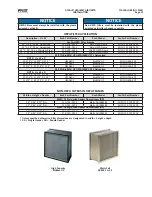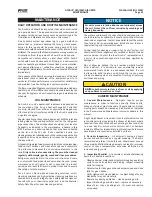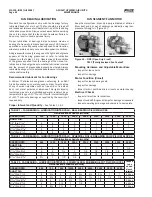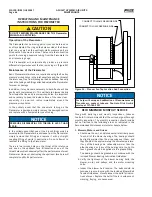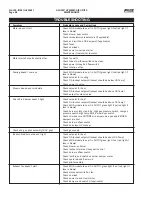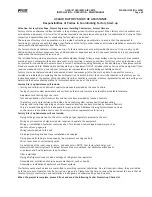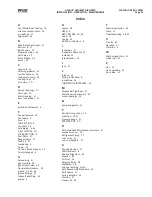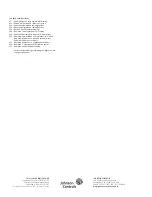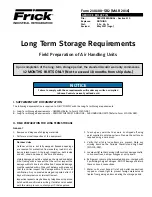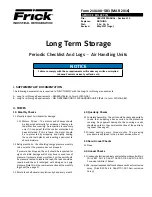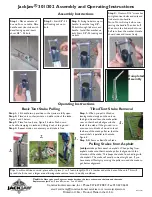
210.100-IOM (JUL 2018)
Page 44
ACUAIR
®
HYGIENIC AIR UNITS
MAINTENANCE
INSPECTING V-BELTS AND SHEAVES
Before a new set of V-belts are installed, inspect the condition
of the sheaves. Dirty or rusty sheaves impair the drive's
efficiency and abrade the belts, which result in premature
failure. (See Figure 51)
Inspect and clean sheaves; replace worn or damaged sheaves-
Worn sheave grooves are one of the principal causes of
premature belt failure.
• Clean dirty, dusty, or rusty sheaves. Feel sheave grooves
(wear gloves or use a rag) for nicks or burrs, and file them
smooth.
• Belts should ride in sheave grooves so that the top of the
belt is just above the highest point of the sheave. If the
grooves are worn to the point where the belt bottoms out
(a clue: check for shiny groove bottoms), the belts will slip
and burn.
• If the groove walls are “dished out,” the bottom corners
of the belt will quickly wear off and cause rapid failure.
Check groove wear by sight, touch, or with a groove gauge.
If grooves are “dished out” 1/32" or more - replace the
sheaves.
DISHING
ORIGINAL
GROOVE
“DISHING” OF GROOVE SIDEWALLS
SHORTENS BELT LIFE
LOW RIDING BELTS
INDICATE WORN GROOVES
BELTS SHOULD
RIDE LIKE THIS
Figure 51 – Sheave Inspection
Inspect
Sheave Alignment
NOTICE
An incorrectly aligned sheave can substantially shorten
belt life or overload blower and motor bearings, short
-
ening their life expectancy. A belt tensioned too tightly
can overload the motor electrically, causing nuisance
tripping of the motor overloads and/or motor failure and/
or shaft failure.
Sheave adjustment should be verified by placing a straight
edge across the sheave faces so that it touches all four points
of contact. Ordinarily, a misalignment of more than one-half of
one degree (one-eighth inch in one foot) will adversely affect
belt life. Improper sheave alignment produces uneven wear on
one side of the belt, causes the belt to roll over in the sheave
or throws all the load on one side of the belt, stretching or
breaking the cords on that side.
After the proper operating tension has been applied to the
belts, verify the following:
• Parallel position of the sheave shafts.
• Correct alignment of sheave grooves.
Sheave alignment and parallelism of shafts is very important.
Proper alignment helps equalize the load across the entire belt
width, thereby reducing wear and extending belt life. Figure
52 shows how to align a synchronous drive properly using a
straightedge (A) or a piece of string (B).
After aligning the sheaves, verify the rigidity of the supporting
framework. Shafts should be well supported to prevent
distortion and a resulting change in the center distance under
load. Do not use spring-loaded or weighted idlers.
Alignment Using A Straightedge (Preferred)
Place a straightedge against the outer edge of the sheaves.
Figure 52
(A) shows the four points where the straight edge
should touch the sheaves. The straight edge should cross the
sheaves at the widest possible part of the sheave.
Alignment Using A String
Tie a string around either shaft and pull it around and across
the outer edge of both sheaves. Figure 52 (B) shows how the
string should touch four points when the drive is properly
aligned.
Belt Replacement
Always replace belts as a matched set. Used belts will always
be longer because of stretcthing and new belts should never
be installed singly on a matched drive.
Follow the steps below to replace belts:
1. Release the tension on the belts by loosening the adjusting
nuts on the fan motor.
2. Remove old belts and verify the sheave alignment with a
straight edge.
3. Install the new belts on the sheave.
CAUTION
Never place the belts on the sheaves by using a screw
-
driver to pry the belt over the rim of the sheave.
TENSIONING V-BELTS AND SHEAVES
General Rules Of Tensioning:
1. Correct belt tensioning data is located on “V-belt Drive
Kit Label”, which is mounted on inside of fan access door.
2. Adjust the belt tension using the adjusting nuts on the
motor mount.
3. The ideal tension is the lowest tension at which the belt
will not slip during start-up.
Summary of Contents for AcuAir
Page 54: ......




